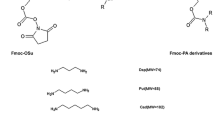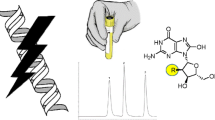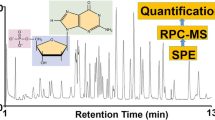Abstract
Polyamines and their N-acetylated metabolites are potential biomarkers in the diagnosis and therapeutic evaluation of cancer. Thus, we present here an ultra high-performance liquid chromatography-tandem mass spectrometry (UHPLC-MS/MS) method for the simultaneous determination of 6 free, 3 monoacetylated, and 2 diacetylated polyamines without derivatization. The major improvement of this method is the use of 0.2 % perfluoroheptanoic acid methanol in the pretreatment step to achieve protein precipitation and 0.0125 % perfluoroheptanoic acid in the mobile phase to achieve analyte separation within 9 min. The established analytical method was validated with plasma, urine, and liver tissue and applied to determine plasma, urine, and liver tissue samples from healthy rats, hepatocellular carcinoma rats, and administrated rats successfully. Results indicated free polyamines such as putrescine mainly existed in liver tissue but more polar N-acetylated metabolites such as N 1,N 12-diacetylspermine seemed to exist in biological fluid. After carcinogenesis, the levels of polyamines were increased, but the elevated levels of polyamines and their metabolites tended to decrease when administrated with anticancer drug. The method provided a more versatile manner for clinical application in the diagnosis and therapeutic evaluation of hepatocellular carcinoma.

The process of quantification of free polyamines and their metabolites in biofluids and liver tissue by UHPLC-MS/MSᅟ



Similar content being viewed by others
References
Goyal L, Supko JG, Berlin J, Blaszkowsky LS, Carpenter A, Heuman DM, Hilderbrand SL, Stuart KE, Cotler S, Senzer NN, Chan E, Berg CL, Clark JW, Hezel AF, Ryan DP, Zhu A (2013) Phase 1 study of N 1,N 11-diethylnorspermine (DENSPM) in patients with advanced hepatocellular carcinoma. Cancer Chemoth Pharm 72:1305–1314
Tan GS, Lim KH, Tan HT, Khoo ML, Tan SH, Toh HC, Ming C, Chung M (2014) Novel proteomic biomarker panel for prediction of aggressive metastatic hepatocellular carcinoma relapse in surgically resectable patients. J Proteome Res 13(11):4833–4846
Moinard C, Cynober L, de Bandt JP (2005) Polyamines: metabolism and implications in human diseases. Clin Nutr 24(2):184–197
Russell DH (1971) Increased polyamine concentrations in the urine of human cancer patients. Nat New Biol 233(39):144–145
Samejima K, Hiramatsu K, Takahashi K, Kawakita M, Kobayashi M, Tsumoto H, Kohda K (2010) Identification and determination of urinary acetylpolyamines in cancer patients by electrospray ionization and time-of-flight mass spectrometry. Anal Biochem 401(1):22–29
Gaboriau F, Havouis R, Moulinoux JP, Delcros JG (2003) Atmospheric pressure chemical ionization-mass spectrometry method to improve the determination of dansylated polyamines. Anal Biochem 318(2):212–220
Häkkinen MR (2011) Polyamine analysis by LC-MS. Methods Mol Biol 720:505–518
Feistner GJ (1994) Profiling of basic amino acids and polyamines in microbial culture supernatants by electrospray mass spectrometry. Biol Mass Spectrom 23(12):784–792
Liu R, Li Q, Ma R, Lin X, Xu H, Bi K (2013) Determination of polyamine metabolome in plasma and urine by ultrahigh performance liquid chromatography–tandem mass spectrometry method: application to identify potential markers for human hepatic cancer. Anal Chim Acta 791:36–45
Häkkinen MR, Roine A, Auriola S, Veskimäe E, Keinänen TA, Lehtimäki T, Oksala N, Vepsäläinen J (2013) Analysis of free, mono-and diacetylated polyamines from human urine by LC–MS/MS. J Chromatogr, B 941:81–89
Sánchez-López J, Camañes G, Flors V, Vicent C, Pastor V, Vicedo B, Cerezo M, García-Agustín P (2009) Underivatized polyamine analysis in plant samples by ion pair LC coupled with electrospray tandem mass spectrometry. Plant Physiol Bioch 47(7):592–598
Acknowledgments
This study was financially supported by the National Natural Science Funds of China (grant No. 81102784/H2803), the key project in scientific research from the Ministry of Education (grant No. 202032), and Liaoning Innovative Research Team in university (LNIRT No. LT2013022).
Author information
Authors and Affiliations
Corresponding author
Electronic supplementary material
Below is the link to the electronic supplementary material.
ESM 1
(PDF 3611 kb)
Rights and permissions
About this article
Cite this article
Yu, C., Liu, R., Xie, C. et al. Quantification of free polyamines and their metabolites in biofluids and liver tissue by UHPLC-MS/MS: application to identify the potential biomarkers of hepatocellular carcinoma. Anal Bioanal Chem 407, 6891–6897 (2015). https://doi.org/10.1007/s00216-015-8860-6
Received:
Revised:
Accepted:
Published:
Issue Date:
DOI: https://doi.org/10.1007/s00216-015-8860-6




